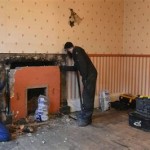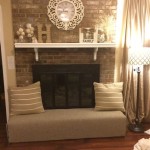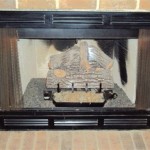Faux Stone For Fireplace: A Comprehensive Guide
Faux stone, also known as manufactured stone veneer, has emerged as a popular material for fireplace surrounds and facades. Its appeal stems from its ability to replicate the aesthetic of natural stone without the associated weight, installation complexity, and cost. This article provides a detailed exploration of faux stone for fireplaces, covering its composition, advantages, installation considerations, design possibilities, and maintenance requirements.
Faux stone is typically composed of a concrete mix that incorporates lightweight aggregates, pigments, and various additives. The mixture is poured into molds meticulously crafted to mimic the texture, shape, and color variations of natural stone. This process allows manufacturers to create a wide array of stone profiles, ranging from stacked stone and fieldstone to river rock and ledgestone. The integration of pigments throughout the material ensures a consistent color saturation, even when the surface is chipped or scratched. The final product offers a durable and visually appealing alternative to natural stone.
Advantages of Using Faux Stone for Fireplaces
The utilization of faux stone in fireplace design presents several significant advantages, making it an attractive option for homeowners and builders alike. These advantages span cost-effectiveness, ease of installation, design flexibility, and material properties.
Cost-Effectiveness: Faux stone is significantly less expensive than naturally quarried stone. The reduced cost is attributable to the manufacturing process, which allows for mass production and lower labor requirements. The transportation costs are also lower due to the lighter weight of faux stone compared to natural stone. Furthermore, the simplified installation process translates into reduced labor costs, making the overall project budget more manageable.
Ease of Installation: The lighter weight of faux stone facilitates easier handling and installation compared to natural stone. Individual pieces can be readily cut and shaped to fit around corners and other architectural features. Installation typically involves adhering the stone veneer to a prepared surface using mortar. The lighter weight also reduces the need for extensive structural support, which can be a significant consideration in renovation projects.
Design Flexibility: Faux stone is available in a vast range of styles, colors, and textures, providing unparalleled design flexibility. This allows homeowners to achieve the desired aesthetic, whether it's a rustic, contemporary, or traditional look. The ability to replicate various natural stone types, such as limestone, granite, and slate, further expands the design possibilities. The consistent quality of manufactured stone ensures that the finished fireplace will have a uniform and visually appealing appearance.
Material Properties: Faux stone is engineered to be durable and weather-resistant. It can withstand temperature fluctuations and exposure to the elements, making it suitable for both indoor and outdoor fireplace applications. The material is also relatively low-maintenance, requiring minimal upkeep to retain its appearance. Furthermore, many faux stone products are fire-resistant, providing an added layer of safety for fireplace installations.
Installation Considerations for Faux Stone Fireplaces
Proper installation is crucial to ensure the longevity and aesthetic appeal of a faux stone fireplace. This process comprises several key steps, including surface preparation, mortar application, stone placement, and finishing touches. Adhering to industry best practices and manufacturer guidelines is essential for a successful installation.
Surface Preparation: The surface to which the faux stone will be applied must be clean, dry, and structurally sound. For concrete or masonry surfaces, any loose or crumbling material should be removed. A scratch coat of mortar is often applied to provide a textured surface for better adhesion. For wood framing, a layer of metal lath is typically installed to provide a strong bonding surface for the mortar. Proper surface preparation is critical to prevent the faux stone from detaching or cracking over time.
Mortar Application: A high-quality mortar specifically designed for stone veneer application should be used. The mortar should be mixed according to the manufacturer's instructions to achieve the correct consistency. Apply the mortar to the back of each stone veneer piece using a trowel, ensuring complete coverage. A notched trowel can be used to create ridges in the mortar, which improves adhesion to the substrate. Avoid applying excessive mortar, as this can squeeze out between the stones and create an unsightly appearance.
Stone Placement: Begin laying the faux stone from the bottom up, starting at a corner. Press each stone firmly into the mortar, ensuring that it is properly aligned and level. Maintain consistent spacing between the stones to create a visually appealing pattern. Stagger the joints between the stones to avoid creating vertical lines that can detract from the overall aesthetic. Use a level to ensure that the stones are installed plumb and level.
Finishing Touches: Once the faux stone has been installed, allow the mortar to cure according to the manufacturer's instructions. After the mortar has cured, use a brush or sponge to remove any excess mortar from the stone surfaces. Point the joints between the stones with mortar to create a finished look. Consider applying a sealant to protect the faux stone from moisture and staining. Regular cleaning and maintenance will help to keep the fireplace looking its best for years to come.
Design Possibilities with Faux Stone Fireplaces
The versatility of faux stone allows for a wide range of design possibilities in fireplace construction. From rustic cabins to modern lofts, faux stone can be used to create a fireplace that complements any architectural style. Consider the following design elements when incorporating faux stone into a fireplace project.
Stone Profiles: The selection of the stone profile significantly influences the overall aesthetic of the fireplace. Stacked stone profiles create a contemporary and minimalist look, while fieldstone profiles offer a more rustic and traditional appearance. River rock profiles evoke a natural and organic feel, while ledgestone profiles provide a textured and dimensional design. Choose a stone profile that complements the architectural style of the room and reflects the desired ambiance.
Color Palette: The color of the faux stone should harmonize with the surrounding décor and create a cohesive design. Neutral tones, such as gray, beige, and brown, are versatile and can be easily integrated into various color schemes. Warmer tones, such as tan and reddish-brown, create a cozy and inviting atmosphere. Consider the lighting in the room when selecting the color of the faux stone, as different lighting conditions can affect the perceived color.
Fireplace Surround Design: The design of the fireplace surround plays a crucial role in the overall aesthetic. A full wall of faux stone can create a dramatic and focal point, while a partial surround can be used to highlight specific architectural features. Consider incorporating other materials, such as wood, metal, or tile, to create a visually interesting and textured design. The use of a mantel and hearth can further enhance the fireplace's aesthetic appeal.
Indoor vs. Outdoor Use: Faux stone is suitable for both indoor and outdoor fireplace applications. For outdoor fireplaces, choose a faux stone product that is specifically designed for exterior use and is resistant to weathering and UV exposure. Consider the surrounding landscape and architectural style when designing an outdoor fireplace. Incorporate features such as seating areas, built-in grills, or outdoor lighting to create a functional and inviting outdoor living space.
The successful implementation of faux stone in fireplace construction necessitates careful planning, proper installation techniques, and a keen eye for design. When these elements are thoughtfully considered, faux stone can provide a durable, cost-effective, and aesthetically pleasing alternative to natural stone.

Jerre S Faux Stone Fireplace Surround Genstone

Stone Fireplace Design And Remodel

Jerre S Faux Stone Fireplace Surround Genstone

Diy Faux Stone Fireplace Chimney H2obungalow

How To Install Faux Stone Veneer Lowe S

43 Top Fireplace Interior Design Stacked Stone Fireplaces Faux Veneer

Thin Stone Veneers Make A Fireplace Update Easy Swenson Granite 100 Natural Stones

Stone Fireplace Makeover Part 2 Faux Whitewash Organized Ish

Faux Stone For Fireplaces

Allen Roth 65 In W Grey Faux Stacked Stone Infrared Quartz Electric Fireplace The Fireplaces Department At Com
Related Posts








